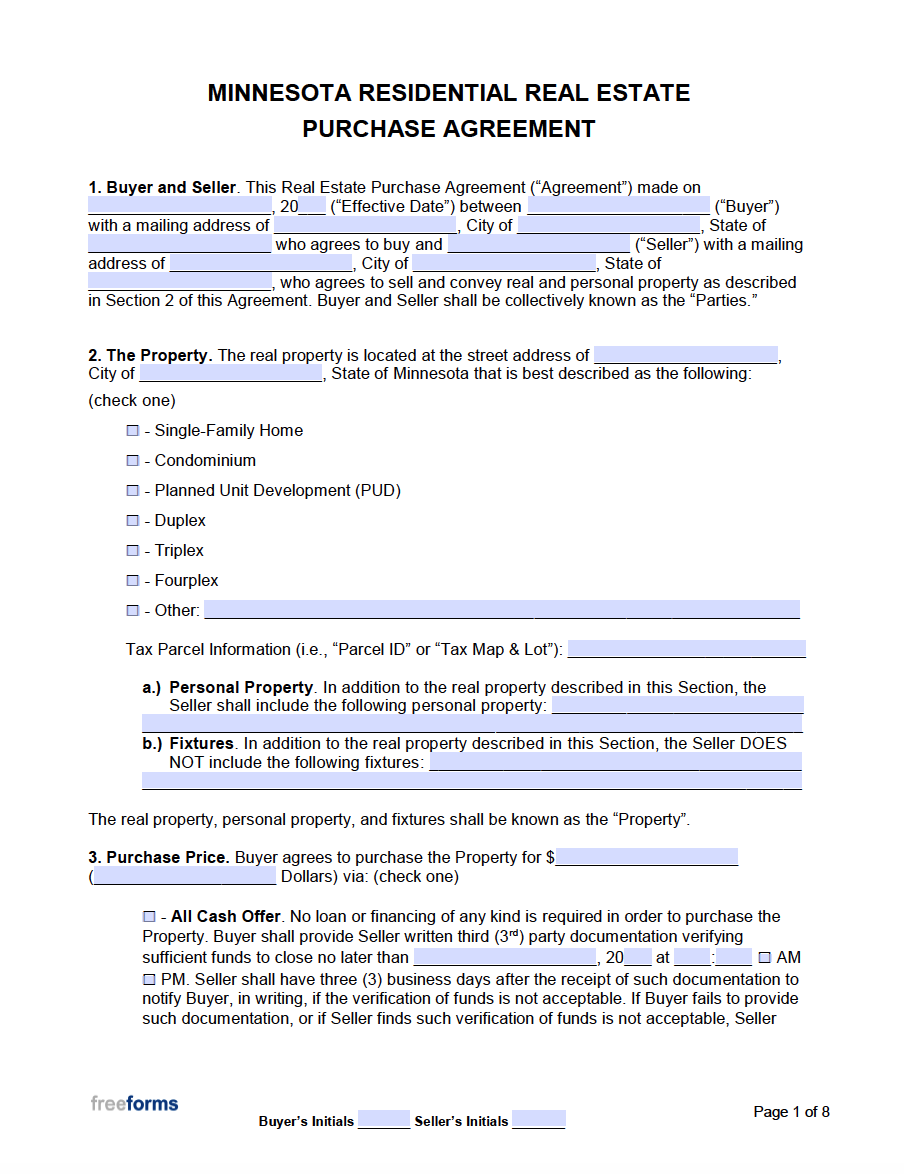The Minnesota purchase agreement records the negotiated terms of a real estate transaction. Prospective buyers can use this form to submit an offer for the seller to accept or counter. The offer includes a bid, preferred closing date, and desired contingencies.
If both parties agree to its terms, they can sign the document to establish a legal contract.
The Home Seller’s Handbook, provided by the The Office of the Minnesota Attorney General, guides residents through the process of selling their residential property.
Required Disclosures
Airport Zoning (§ 513.56(3)(c)) – A seller is excused from the responsibility of informing the buyer of details concerning the airport zoning regulations if they supply them with a disclosure statement expressing that this information can be acquired at the local office of the county recorder.
Common Interest Community Resale (§ 515B.4-101) – If the property for sale is part of a common interest community, the seller/declarant will need to provide the prospective buyer with documentation that covers matters such as the rules & regulations of the community, whether or not they will need to become a member of an association, and expenses/special fees that may be imposed (a full list of the disclosure’s requirements can be found in § 515B.4-102).
Condition of the Property Disclosure (RPF15) (§ 513.55) – As required in most states, Minnesota compels sellers to execute a disclosure report that catalogs all the property’s known material defects, as well as the overall condition of the structure and appliances within it. (This must be accomplished prior to signing any type of sales contract.)
Contracts for Deed (§ 559.202) – If the individual who put the property on the market is a “multiple seller”, they are obligated to complete and attach the notice linked in the title to the front page of the purchase agreement.
Lead-Based Paint Disclosure (42 U.S.C. § 4852d) – The U.S. code of law stipulates that anyone selling their home must first collect all records concerning the existence of lead-paint/lead-paint hazards within the property and deliver them unto the buyer. The transferor must also provide an informational packet authored by the Environmental Protection Agency. (This regulation is only necessary for properties that originated before 1978.)
Location of Wells (§ 103I.235) – Selling party must convey to the purchaser the location of any wells within the property lines and give a brief description of their current status.
Methamphetamine Production (§ 152.0275(m)) – The vendor of a property that housed a clandestine lab is liable to furnish a written disclosure to any potential buyers notifying them of this fact and detailing all the subsequent remediation efforts.
Radon (§ 144.496(3)) – This disclosure must be introduced to the prospective buyer before officially entering into a contract. It insists that the seller supply any records related to the presence of radon within the dwelling, a statement explaining the risks involved with the radioactive gas, and the MDH’s “Radon in Real Estate Transactions” publication.
Real Property Contaminated with Hazardous Substances (§ 115B.16(2)) – Minnesota law instructs sellers of properties that have been negatively affected by hazardous waste disposal to reveal this knowledge by fulfilling the affidavit linked in the title. (Must be presented to the county recorder for processing.)
Storage Tanks (§ 116.48(6)) – Properties that contain either an aboveground or underground storage tank require the seller to execute an affidavit that provides a description of the tank as well as its location. The form must then be delivered to the county recorder for verification purposes. Once it has been recorded, the seller must collect a copy of the document to present to the prospective buyer for full disclosure.
Subsurface Sewage Treatment System (§ 115.55(6)) – Before the legal transfer of property can occur, the seller is obliged to express, in writing, how the property’s sewage system operates. (The Minnesota Pollution Control Agency offers a brief guide on Disclosing SSTS at Property Transfer.)
Valuation Exclusion (§ 273.11(18)) – If the residence for sale has an exclusion from market value for home improvements regarding property tax, the seller shall disclose this information to the buyer and notify them that the property’s estimated market value for property tax purposes will increase upon the exchange.
Realtor Version
Minnesota State Bar Association – PDF



0 comments
Comments are closed.